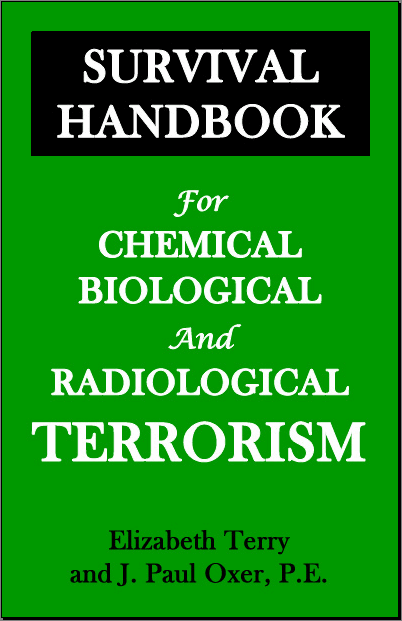Survival Handbook for Chemical, Biological and Radiological Terrorism
A PRACTICAL GUIDE FOR PROTECTION AGAINST CHEMICAL, BIOLOGICAL, AND RADIOLOGICAL TERRORISM
The first few minutes after a chemical, biological, or radiological (CBR) terrorist attack are the most critical, and actions can be taken to save lives. The first priority is to avoid or reduce exposure. Every minute lost may cost lives, and it is unlikely that experts will be present immediately to advise. Safety lies not in expensive equipment, but in knowledge of these weapons and the defensive actions that can confer protection.
"Each CBR attack that successfully kills people and disrupts our lives creates incentive for further attacks. If nothing else, CBR attacks gain a large amount of publicity. If as a nation we can show ourselves capable of limiting the damage of these attacks, the cost of acquiring, transporting, and handling CBR materials may make them less attractive as weapons for terrorists. To the extent that we do not appear vulnerable and can contain the damage and move on with our business and our lives, CBR weapons may quickly lose their appeal. This is the ultimate goal of preparedness."
from the Survival Handbook for Chemical, Biological and Radiological Terrorism
Elizabeth Terry and J. Paul Oxer

Do you know how to protect yourself during a chemical, biological, or radiological terrorist attack?
What protects and what does not?
How safe is your water supply?
How great is your risk of experiencing an attack?
Can you recognize the signs and signals of chemical, biological, or radiological terrorist attack?
Few people have practical understanding of CBR weapons. The closest counterpart that may occur to many is a fire emergency. But there are significant differences that could make a fire emergency protocol dangerous to follow in a CBR attack. Fires are associated with buildings, and escape from the building means escape from the fire. CBR materials can be released in a parking lot or in the street, and a building may be the safest place to be. Secondly, we are all familiar with fire, and we can see the flames, smell the smoke, and feel the heat. Although CBR release is often referred to as a "cloud," these deadly materials in the air may be invisible, leaving people to walk right into them unaware of the danger.
THIS BOOK CAN PROVIDE THE INFORMATION YOU NEED FOR A CHEMICAL, BIOLOGICAL, AND RADIOLOGICAL TERRORISM EMERGENCY.
This book is written for individuals, families, and security professionals to form the basis for the immediate decisions necessary to save lives. The most important section contains the Emergency Response Protocols, providing prioritized instructions for those caught in a CBR attack. The Handbook also provides information necessary to evaluate the utility of equipment available for CBR protection, including gas masks, personal filter masks, and air filters.
Other important features of the book include guidelines for analyzing risk of CBR terrorism based on geographic location, and on international visibility as an attractive terrorist target. A format for assessment of vulnerabilities to CBR attack based on site characteristics and business profiles is also presented. Protection of water supplies from CBR attack is addressed. A detailed listing of attack indicators is provided, and can serve as a first alert if known and recognized.
As a member of the National Intelligence Council at the time of the first war with Iraq, Elizabeth Terry guided the Secret Service, FBI, and Department of Defense in identifying vulnerabilities of key Government facilities, including the White House, Capital Building, and Pentagon, to chemical, biological, and radiological terrorism and establishing protective measures. Since that time, she has worked with major U.S. corporations, providing vulnerabilities studies and awareness seminars focusing on this special type of terrorism.
J. Paul Oxer's extensive career in technical and management consulting has included development of international projects for potable water supply, waste water collection and treatment. J. Paul holds a Bachelors Degree in Civil Engineering from the Georgia Institute of Technology. He is a licensed Professional Engineer and a Diplomate of the American Academy of Environmental Engineers and a member of the National Defense Executive Reserve assigned to the Federal Emergency Management Agency (FEMA) in water resources management.